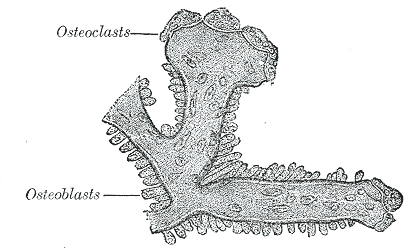Bisphosphonates in Osteoporosis
Osteoporosis is a common health problem in elderly females. This is mostly because of the abrupt hormonal changes taking place after menopause, and so is called postmenopausal osteoporosis. The word “osteoporosis” perfectly describes the disease, which consists of cellular changes leading to thinning (increased porosity) of bones (Gk. osteon = pertaining to bones). This is followed by bone pains, fractures from trivial falls, and so on. The spectrum of symptoms in osteoporosis is endless, but the cause is frequently the same, a functional imbalance in bone tissue.
Cellular changes in Osteoporosis
Even after completion of growth, the bones of our body are continuously renewed by the cells present within the bones. There are two types of cells within the bones – osteoblasts and osteoclasts.
Picture 1: Osteoblasts and Osteoclasts
(Source: Wikimedia Commons)
Osteoblasts (Picture 1) are bone forming cells, which continuously keep adding layers of bone tissue over existing bones. Thus, they help in adding calcium from blood into the bones, making them stronger and thicker. However, with increasing age, menopause, or endocrine disorders (like hyperparathyroidism, thyroid disorders, Cushing’s syndrome, and so on), the number of osteoblasts starts decreasing, and so does their functional capacity to add layers of new bone tissue.
Osteoclasts (Picture 1) are bone dissolving cells, which continuously keep removing layers of bone tissue. They help in reshaping and renewing of bones, which helps in maintaining the consistency of bones as well as neutralizing the minute defects of day to day stress and trivial traumatic incidents. However, unbalanced activity of osteoclasts can cause excessive erosion of bones leading to osteoporosis.
Thus, relative dominance of the osteoclasts in an individual, is the key event leading to osteoporosis !
Role of Bisphosphonates
Bisphosphonates have revolutionized the therapy of osteoporosis, by acting directly at the cellular level, i.e. on the osteoclasts. Bisphosphonates are structurally similar to pyrophosphate (a form of phosphorus which is bound to calcium and present in bones), and so are incorporated into bone tissue. As the bone tissue is dissolved, bisphosphonates are taken up by osteoclasts. This helps in preferential killing of osteoclasts, and thus, the delicate balance between bone forming and bone dissolving systems is maintained.
Picture 2: Bisphosphonate structure
(Source: Wikimedia Commons)
Bisphosphonates are highly effective in preventing bone loss in osteoporosis. It has been documented by numerous studies, that treatment with bisphosphonates leads to reduction in number of fractures due to senile, postmenopausal, or endocrine osteoporosis. Unlike other forms of therapy, like calcium supplementation, hormonal replacement, and so on, bisphosphonates are highly specific to the problem of osteoporosis, right up to the cellular level. Hence, many of the unpleasant side-effects are easily avoided !
Types of Bisphosphonates
Bisphosphonates used in common practice are
- Alendronate
- Risedronate
- Ibandronate
- Pamidronate
- Zolendronate
Other Uses of Bisphosphonates
Paget’s disease is associated with an over-reactive bone forming and bone dissolving systems. This leaves a highly disorganised osteoporotic mass of bone tissue in large quantities. Bisphosphonates reduce the bone dissolving process, which controls the reactive bone formation indirectly.
Multiple myeloma is a bone tumor, which produces an abnormal protein called RANKL. This protein activates the osteoclasts leading to patchy destruction of bones. Bisphosphonates prevent this and provide symptomatic relief. However they are unable to control the primary disease and so are of limited value.
Breast cancer is known to spread to bones of the spinal column by metastasis. Treatment with bisphosphonates not only prevents vertebral metastasis (secondary bone cancer), but also prevents the likelihood of getting invasive breast cancer.






